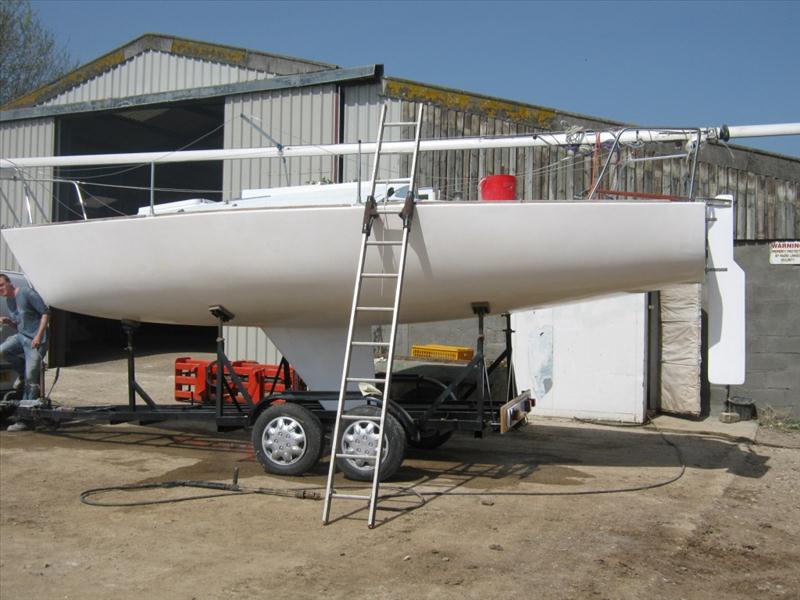
The refurbishment of a 1979 Westerly J/24 Jiggy With It
by Nathan Batchelor 19 May 2010 11:38 BST

The refurbishment of a 1979 Westerly J/24 'Jiggy With It' © Nathan Batchelor
As with all good projects the idea to do up an old J/24 was conceived in the pub one evening when looking for a project for the winter. The plan was to get an old boat and do her up in order for us to join in the competitive Weymouth J/24 fleet racing.
Jiggy was spotted for sale in Falmouth in a fairly neglected state; luckily we were racing in Falmouth that weekend and jumped on a RIB to have a look at her on a mooring off Mylor. After some negotiations a deal was struck with Truro College.
Initial problems to overcome:
- How do we get the boat out of the water
- How do we get it back to Weymouth with a trailer which was a yard trailer at best
- Mast had a hairline crack in it by the forestay fitting
Luckily all 3 problems were solved by Robin ‘Copper’ Edwards from Portscatho. On very wet October day I motored Jiggy from Mylor, past St. Mawes to Percuil (J’S do like to roll with no rig up and waves!), where Copper lifted her out on special wooden A-frames onto his own large yacht trailer. A quick bit of welding later, the mast was done, and it was all delivered to a barn near Weymouth.
After a thorough investigation we realised that the fundamentals of our slighty under-researched purchase were sound. The keel stub had already been strengthed, and we discovered that she had a great result at the 2006 Europeans - all good foundations. However, cosmetically she was in a pretty poor state, the decks had been repainted many times and the antifoul applied in a fairly cavalier fashion!
The main jobs we undertook were:
- Lowering the companion way hatch
- Respray painting the deck
- Rebuilding the keel
- Removal of superflous gear and fittings. (her last weight was 1321kg but only a few years earlier she had been 1306kg)
Lowering companion way hatch
This job was undertaken on Bob Turner’s advice - lowering the hatch makes it much easier for the crew to work around the boat. We also did this to modernise the look of the boat. The old high teak sides to the hatch were very waterlogged , the new hatch surround was difficult to build but very worthwhile.
Respraying the deck
This was definately the biggest job, largely because of the mess the previous owners had made in painting the decks. The paint was flaking off in places, and the decks looked like a patchwork of the 3 previous paint jobs. The topcoat of paint was so thick that orbital sanders would not get through it, chiselling was too slow, so we hired an industrial floor board stripper and got to work!
Rebuilding the keel
All the layers of old antifoul and loose bits were removed, and then the keel was built up of layers of epoxy, before the final fairing was done with body filler.
Removal of Redundant Equipment
This was the fun bit! Everything got removed - ancient echo sounder/ log, all nav lights, brackets on metal work, interior lights and all associated wiring. The fixed bilge pump, fixed compass, the inside of the now sealead lazerette lockers, even the basin got some attention.! The new lower hatch was considerably smoother. We also built a new carbon outboard bracket weighing in at 1.0kg to replace the 3.6kg lifting original. Then after being out the water for 6 months with a dehumidifier, we had dried her out completely.
Other work was done to modernise the boat, including reconfiguring the cockpit layout, copying that of Bob Turner’s Serco boats. New angled winch pods were fitted, along with new cleats, blocks and ropes.
This aticle has concentrated on the main jobs we did, there were many many more which I have not mentioned. Over 15 old gelcoat repairs had to be redone, lots of work on the topsides to remove 30 years of staining in the fibreglass (not to mention where Truro College stickers were). The final job was for Stuart Jardine to give the boat a thorough check and weighed her, and we were very pleased that she came in at 1275kg.
We certainly learnt a lot of lessons but the bottom line is that you can buy an old J24 boat which may look very shabby but with good advice and shedloads of hardwork you can end up with a great looking boat, which with the right crew and sails will certainly perform.
A big thanks must go to all those who helped us out with J/24 specfic advice, and I must thank Alex Knight for all the work he undertook in doing the skilled jobs on the rebuild.
